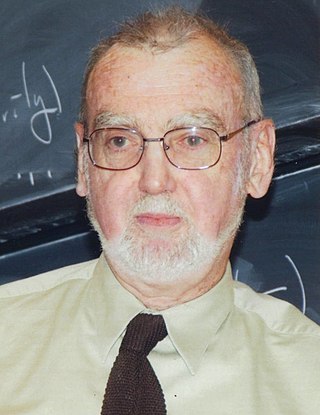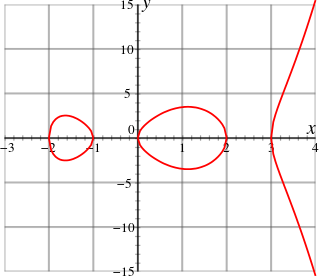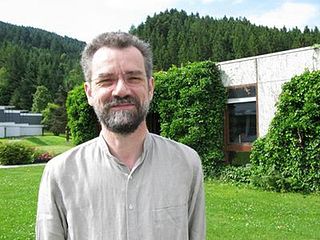Related Research Articles

Robert Phelan Langlands, is a Canadian mathematician. He is best known as the founder of the Langlands program, a vast web of conjectures and results connecting representation theory and automorphic forms to the study of Galois groups in number theory, for which he received the 2018 Abel Prize. He is emeritus professor and occupied Albert Einstein's office at the Institute for Advanced Study in Princeton, until 2020 when he retired.
In mathematics, the Langlands program is a set of conjectures about connections between number theory and geometry. It was proposed by Robert Langlands. It seeks to relate Galois groups in algebraic number theory to automorphic forms and representation theory of algebraic groups over local fields and adeles. It is the biggest project in mathematical research. It was described by Edward Frenkel as "grand unified theory of mathematics."
The modularity theorem states that elliptic curves over the field of rational numbers are related to modular forms in a particular way. Andrew Wiles and Richard Taylor proved the modularity theorem for semistable elliptic curves, which was enough to imply Fermat's Last Theorem. Later, a series of papers by Wiles's former students Brian Conrad, Fred Diamond and Richard Taylor, culminating in a joint paper with Christophe Breuil, extended Wiles's techniques to prove the full modularity theorem in 2001.
Gorō Shimura was a Japanese mathematician and Michael Henry Strater Professor Emeritus of Mathematics at Princeton University who worked in number theory, automorphic forms, and arithmetic geometry. He was known for developing the theory of complex multiplication of abelian varieties and Shimura varieties, as well as posing the Taniyama–Shimura conjecture which ultimately led to the proof of Fermat's Last Theorem.

Pierre René, Viscount Deligne is a Belgian mathematician. He is best known for work on the Weil conjectures, leading to a complete proof in 1973. He is the winner of the 2013 Abel Prize, 2008 Wolf Prize, 1988 Crafoord Prize, and 1978 Fields Medal.
In mathematics, in particular in the theory of modular forms, a Hecke operator, studied by Erich Hecke, is a certain kind of "averaging" operator that plays a significant role in the structure of vector spaces of modular forms and more general automorphic representations.
In harmonic analysis and number theory, an automorphic form is a well-behaved function from a topological group G to the complex numbers which is invariant under the action of a discrete subgroup of the topological group. Automorphic forms are a generalization of the idea of periodic functions in Euclidean space to general topological groups.
In mathematics, the Ramanujan conjecture, due to Srinivasa Ramanujan (1916, p. 176), states that Ramanujan's tau function given by the Fourier coefficients τ(n) of the cusp form Δ(z) of weight 12
Vladimir Gershonovich Drinfeld, surname also romanized as Drinfel'd, is a mathematician from the former USSR, who emigrated to the United States and is currently working at the University of Chicago.

In mathematics, arithmetic geometry is roughly the application of techniques from algebraic geometry to problems in number theory. Arithmetic geometry is centered around Diophantine geometry, the study of rational points of algebraic varieties.
In mathematics, an Artin L-function is a type of Dirichlet series associated to a linear representation ρ of a Galois group G. These functions were introduced in 1923 by Emil Artin, in connection with his research into class field theory. Their fundamental properties, in particular the Artin conjecture described below, have turned out to be resistant to easy proof. One of the aims of proposed non-abelian class field theory is to incorporate the complex-analytic nature of Artin L-functions into a larger framework, such as is provided by automorphic forms and the Langlands program. So far, only a small part of such a theory has been put on a firm basis.

Akshay Venkatesh is an Australian-American mathematician and a professor at the School of Mathematics at the Institute for Advanced Study. His research interests are in the fields of counting, equidistribution problems in automorphic forms and number theory, in particular representation theory, locally symmetric spaces, ergodic theory, and algebraic topology.
In number theory, a Shimura variety is a higher-dimensional analogue of a modular curve that arises as a quotient variety of a Hermitian symmetric space by a congruence subgroup of a reductive algebraic group defined over Q. Shimura varieties are not algebraic varieties but are families of algebraic varieties. Shimura curves are the one-dimensional Shimura varieties. Hilbert modular surfaces and Siegel modular varieties are among the best known classes of Shimura varieties.
In mathematics, the Rankin–Selberg method, introduced by Rankin and Selberg, also known as the theory of integral representations of L-functions, is a technique for directly constructing and analytically continuing several important examples of automorphic L-functions. Some authors reserve the term for a special type of integral representation, namely those that involve an Eisenstein series. It has been one of the most powerful techniques for studying the Langlands program.
In mathematics, the Hecke algebra of a pair (G, K) of locally compact or reductive Lie groups is an algebra of measures under convolution. It can also be defined for a pair (g,K) of a maximal compact subgroup K of a Lie group with Lie algebra g, in which case the Hecke algebra is an algebra with an approximate identity, whose approximately unital modules are the same as K-finite representations of the pairs (g,K).
In mathematics, Lafforgue's theorem, due to Laurent Lafforgue, completes the Langlands program for general linear groups over algebraic function fields, by giving a correspondence between automorphic forms on these groups and representations of Galois groups.

In the mathematical fields of algebraic geometry and arithmetic geometry, the Consani–Scholten quintic is an algebraic hypersurface studied in 2001 by Caterina Consani and Jasper Scholten. It has been used as a test case for the Langlands program.
Don Malcolm Blasius is an American mathematician.

Peter Bernd Schneider is a German mathematician, specializing in the p-adic aspects of algebraic number theory, arithmetic algebraic geometry, and representation theory.
James Wesley Cogdell is an American mathematician.
References
- Bump, Daniel (1997). Automorphic Forms and Representations. Cambridge Studies in Advanced Mathematics. Vol. 55. Cambridge University Press.
- Serre, Jean-Pierre (1973). A Course in Arithmetic. Graduate Texts in Mathematics. New York: Springer Science+Business Media.